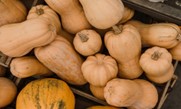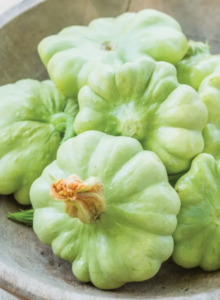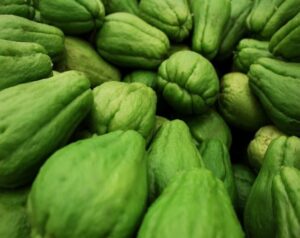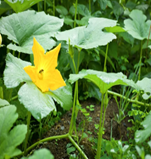Garden2Table – Can I Freeze Squash?

Can I Freeze Squash?
From: Kellogg Garden July 2022 Blog
Bring a hint of summertime into your meals throughout the entire year by freezing squash and preserving at its peak of freshness. No matter what kind of squash you harvest or buy at your local Grower’s Market, there is a way to retain its freshly picked essence. When harvest time comes around and you have so much squash you don’t know what to do with it, you’ve shared with all your neighbors, and exhausted all your creative ways of cooking your crop – freezing squash can be a lifesaver. Freezing squash will preserve it in ready to eat form so that it is available for all your favorite meals throughout the entire year.
How to Freeze Squash
Freezing squash successfully varies with the type of squash you aim to preserve. No matter what kind of squash you plan to freeze this guide will help you find the best method to preserve it so its best when you take it out of the freezer.
- Winter squashes can withstand cubing and flash freeze alone
- Freezing spaghetti squash requires more cooking and prep before storing
- Summer squash and zucchini rely on blanching and flash freezing for maximum preservation

Butternut squash photo by Pexels.com
Winter squashes, like butternut squash can be stored in a cool dry place for a couple of months, freezing butternut squash can extend the viability of this vitamin rich garden favorite. Once properly stored, butternut squash can be thawed and roasted, or tossed into soups and stews without much fuss
The optimal way to freeze butternut, or any other winter squash is to peel the squash, remove all the seeds and cut it into 1 inch cubes. Spead the cubes in single layer on a parchment lined baking sheet and place them in the freezer for one hour. When thoroughly frozen, transfer the squash to a freezer bag
Can I Freeze Spaghetti Squash?
Freezing a spaghetti variety requires more preparation than other squashes. Spaghetti squash is known for its pasta-esque strands of delicious goodness that are low in calories while rich in vitamin A, beta carotene, potassium and folic acid. Properly preserved spaghetti squash makes a fantastic instant meal option that will give that summer taste that is even more delicious on a cold winter day.
Here’s how to get the most out of your spaghetti squash when freezing it
- Preheat the oven to 375 degrees
- Slice the squash in half from end to end and remove all the seeds
- Place the squash halves on a baking sheet – skin side down
- Bake 30 to 335 minutes until squash is fork tender
- Take squash out of the oven and allow it to cool
- Run a fork along the length of the squash to loosen the spaghetti like strands of flesh
- Place the strands in a strainer atop a large bowl to remove the drainage
- Cover and store strainer of squash and draining bowl in the refrigerator for 12 hours
- Discard the liquid that has been drained from the squash
- Pack the drained squash strands into freezer bags, removing any excess air from the bag, and store in freezer for up to one year
Freezing Summer Squash
Successfully freezing summer squash requires a little bit of knowledge and a few simple steps. If you only slice up or cube summer squash and flash freeze it, you will likely end up with a mushy and disappointing unveiling when you defrost it—blanching squash before flash freezing squash makes all of the difference for preserving the texture of your squash.
Summer Squash Varieties

Patty Pan Squash from Pexels.com
Chayote, Cousa, Pattypan, Yellow Crookneck. Yellow Straight-neck, Zephyr and Zucchini
To freeze these delicate fruits:
- Select freshly picked summer squash for freezing. Inspect the squash and choose squash that is firm and supple with no blemishes.
- Wash squash well in cool water, eliminating dust or pests.
- Use a sharp knife to trim off the ends of the squash.
- Slice or dice squash into uniform slices or cubes.
- Place raw slices or cubes into a pan of unsalted boiling water for one minute – bring back to boil.
- Use a slotted spoon to carefully remove the squash from the boiling water and transfer it immediately to an ice water bath. That will stop the cooking.
- Squash contains a lot of moisture, so it is essential to drain the squash. Lay blanched squash out on a clean kitchen towel. Let drain on counter 8 hours or overnight. Replace towel as needed.
- To keep the squash from sticking together in one mass when it is frozen, flash freezing is necessary. To flash freeze, lay out parchment paper on a baking sheet and spread the slices or cubes of blanched and drained squash in a thin layer. Place the tray in the freezer for one hour.
- Once the squash is frozen, move it to freezer bags or containers and store in freezer for up to one year.
Best Types of Squash for Freezing

Chayote Squash by Pexels.com
These prolific squash varieties will give you plenty of delectable fruits for use right away and will freeze incredibly well for later use.
- ‘Summer Squash Goldetti‘– deep golden skins and substantial sweet fleshy fruits on a bush-like plant.
- ‘Black Beauty’ – produces plentiful deep green zucchini on upright bush-like plant.
- ‘Fordhook Zucchini’ upright, open habit plants which grow prolific green fruits.
- ‘Cocozelle’ – Italina heirloom striped. Light green fruits with ribbed texture
- ‘Green Tiger’ – Stunning light and dark green striped fruits.
- ‘Waltham’ – High performing butternut squash variety with sweet orange flesh and cream-colored skins.
Domestication History of Squash Plant (Cucurbita spp)

Squash blossom by Pexels.com
Squash (genus Cucurbita), including squashes, pumpkins, and gourds, is one of the earliest and most important of plants domesticated in the Americas, along with maize and common bean. The genus includes 12–14 species, at least six of which were domesticated independently in South America, Mesoamerica, and Eastern North America, long before European contact.
Evidence suggests that cucurbit ecology is tightly bound up with one of its pollinators, several varieties of an American stingless bee known as Peponapi or the gourd bee. Ecologist Tereza Cristina Giannini and colleagues identified a co-occurrence of specific types of cucurbit with specific types of Peponapis in three distinct geographic clusters. Cluster A is in the Mojave, Sonoran and Chihuahuan deserts (including P. pruinosa); Cluster B in the moist forests of the Yucatan peninsula and Cluster C in the Sinaloa dry forests.
Peponapis bees may well be crucial to understanding the spread of domesticated squash in the Americas because bees followed the human movement of cultivated squashes into new territories. Entomologist Margarita Lopez-Uribe and colleagues (2016) studied and identified molecular markers of the bee P. pruinose in bee populations throughout North America. P. pruinosa today prefers the wild host C. foetidissima, but when that is not available, it relies on domesticated host plants, C. pepo, C. moschata and C. maxima, for pollen.
